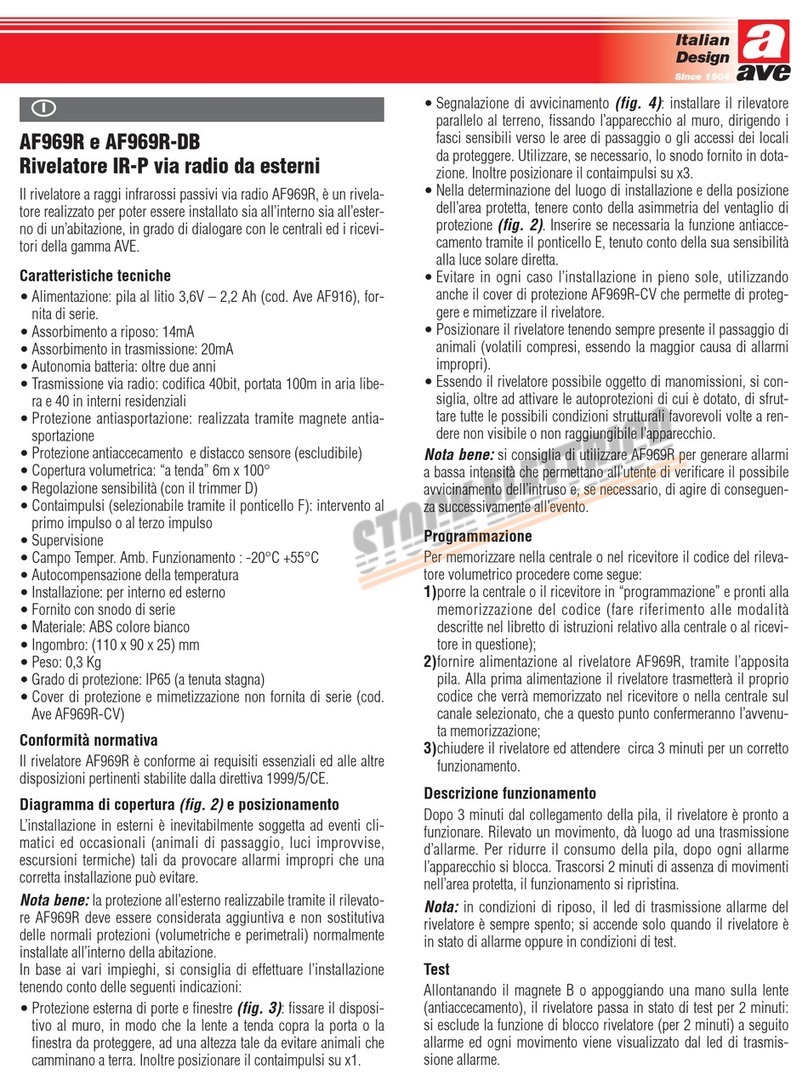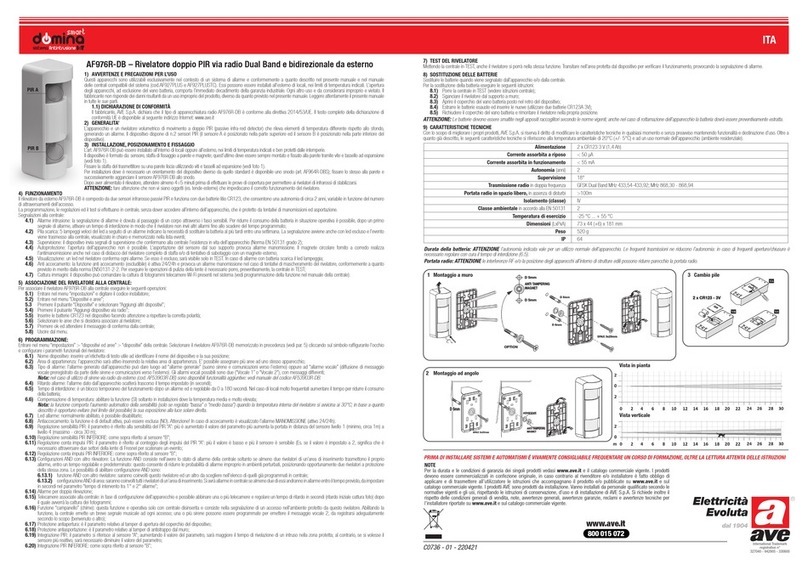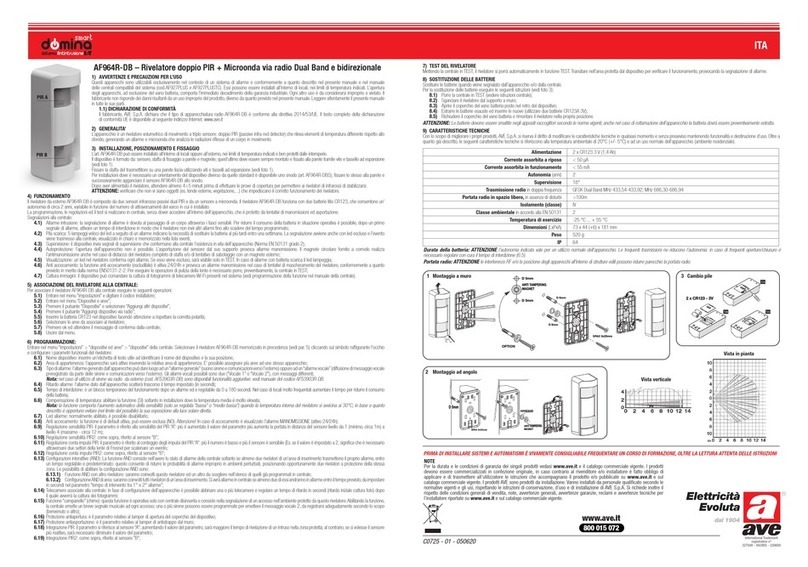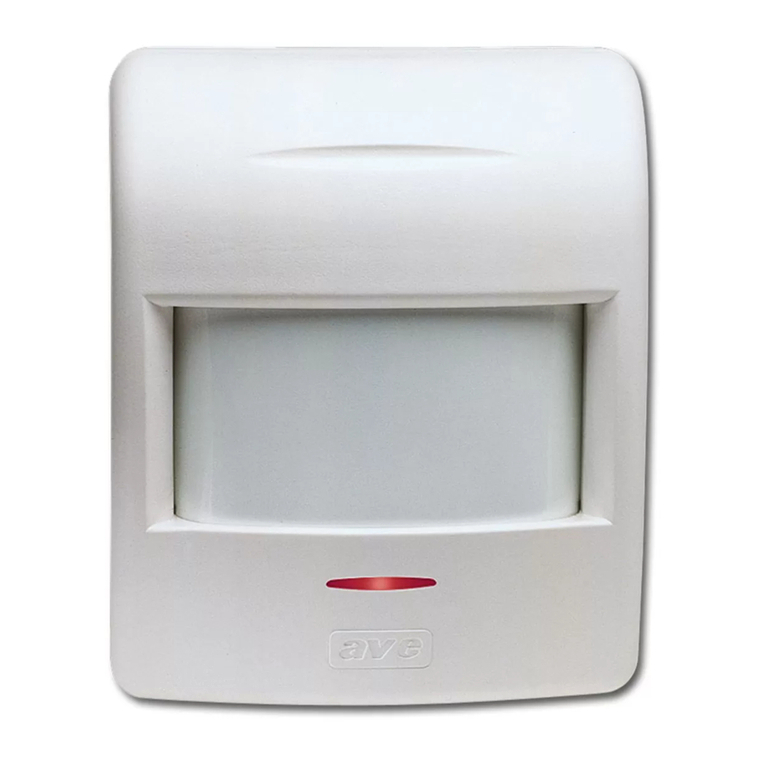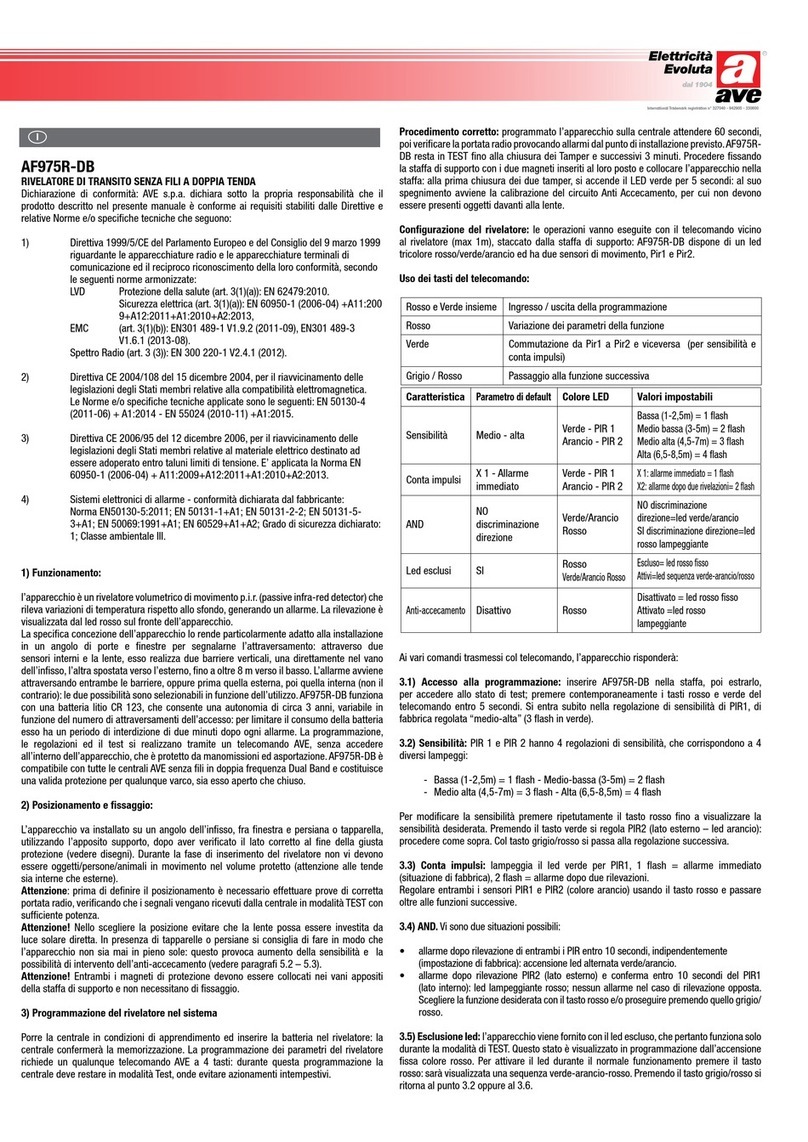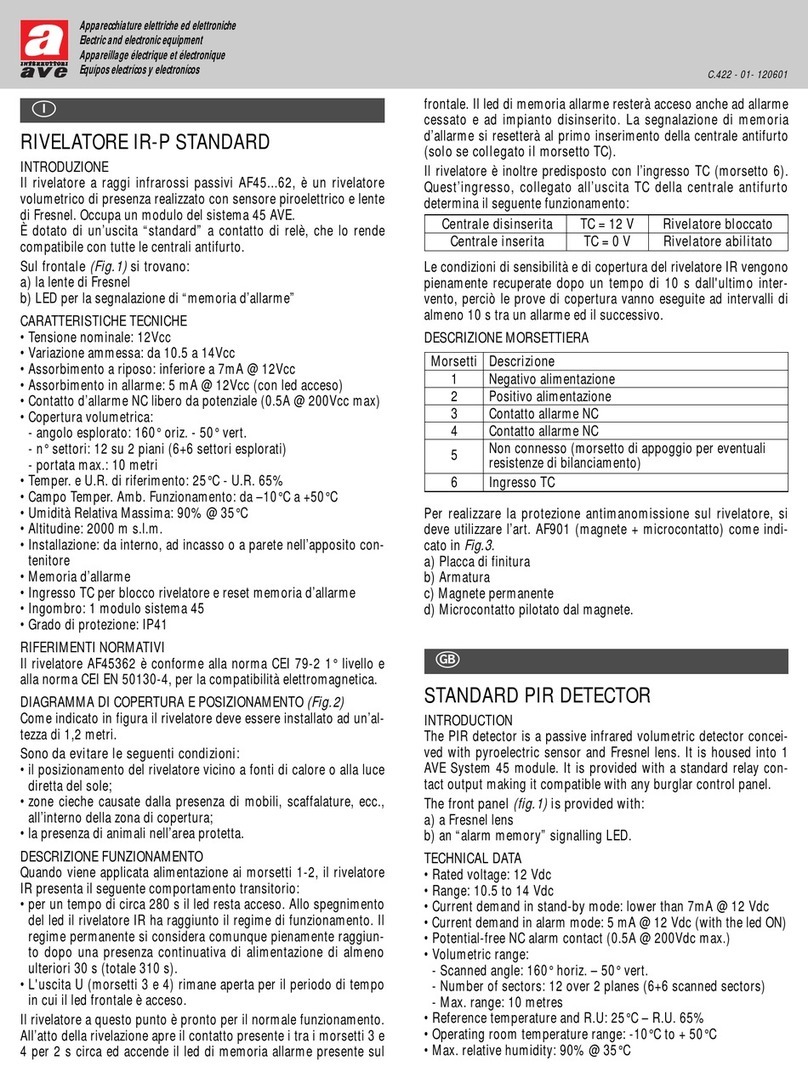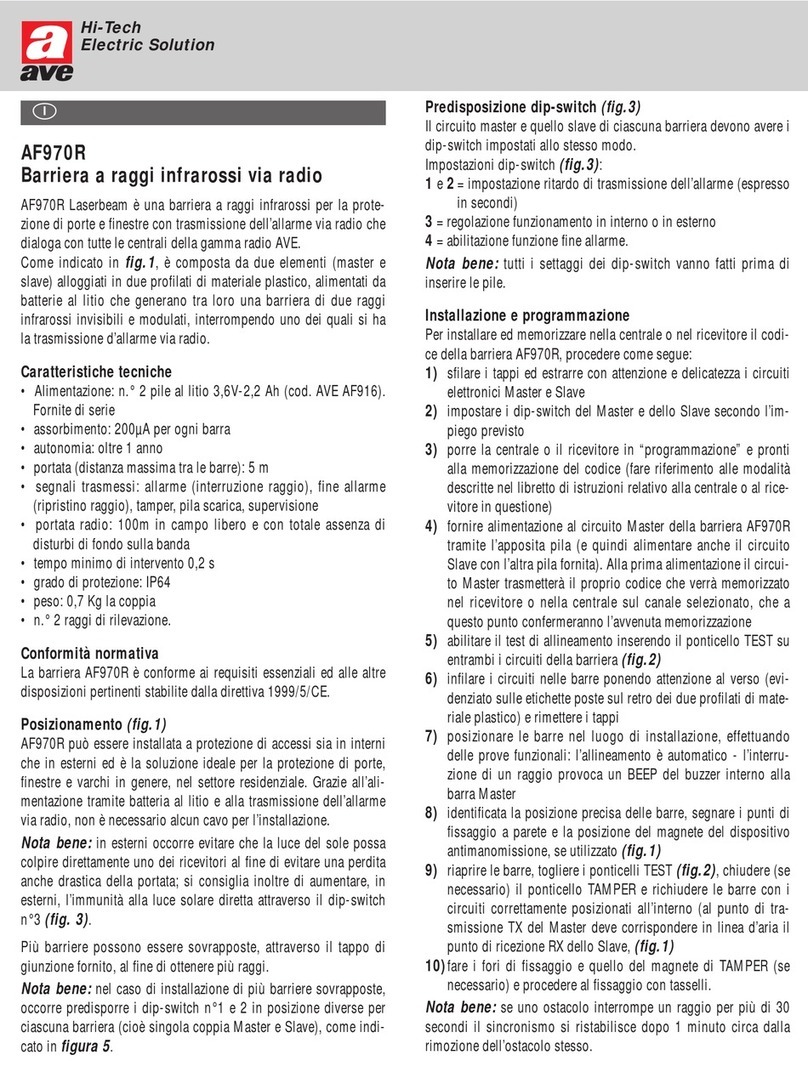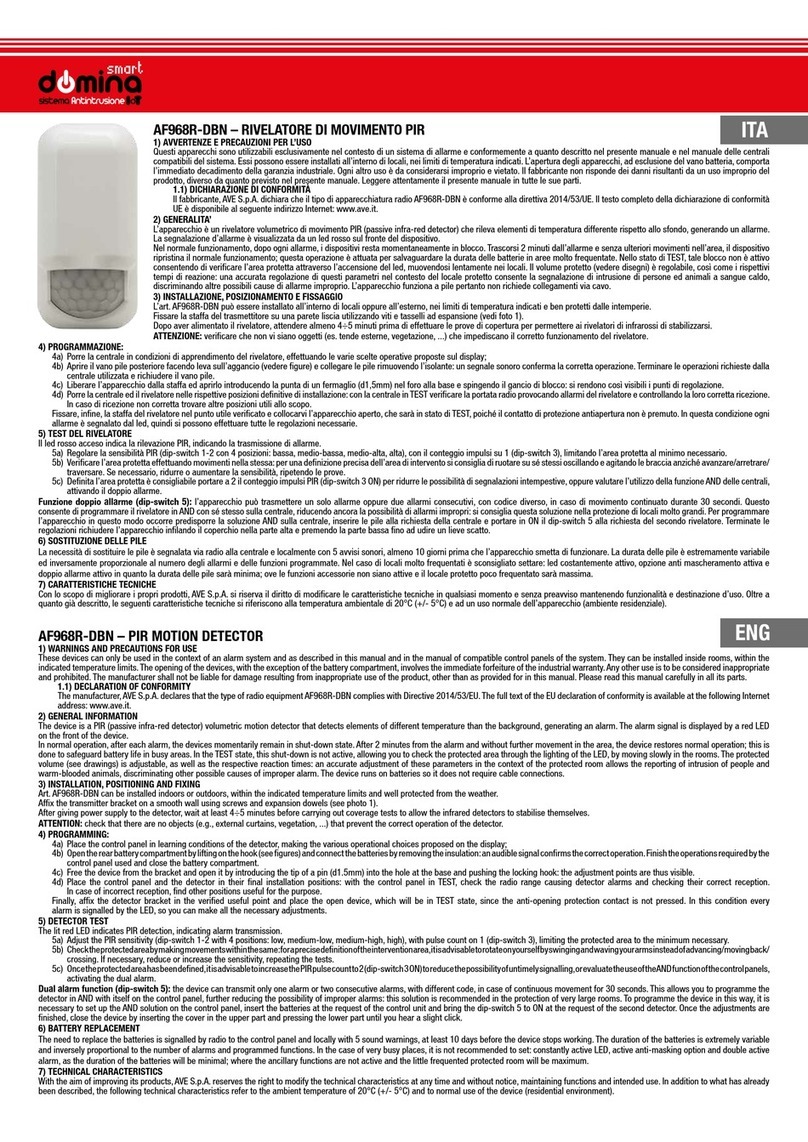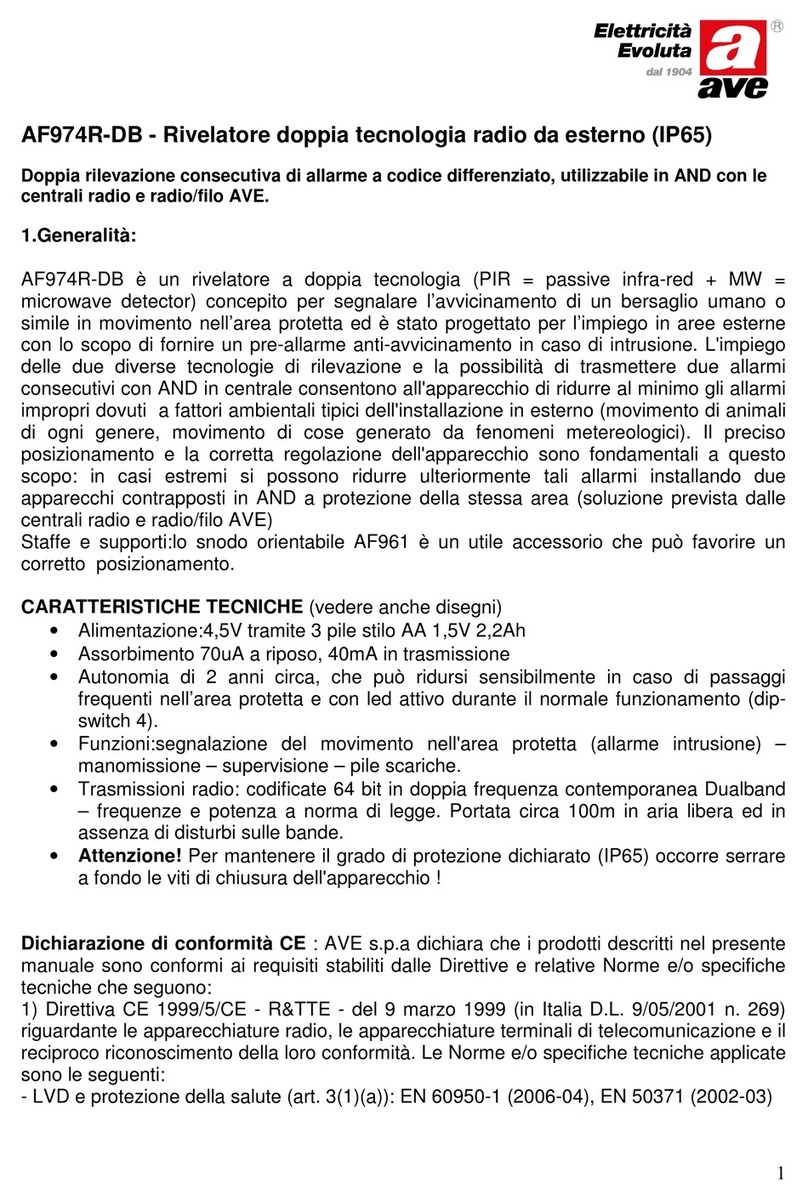
aperta alle intemperie (neve, pioggia battente), possibili cause di allarme impro-
prio.
c) Regolazioni (vedere disegno)
:
Per verificare le regolazioni si utilizza il led dell’apparecchio, che va posto in stato
di TEST (vedere paragrafo 2f): Il led verde indica la rilevazione PIR: successiva-
mente cambia colore in arancio quando il movimento è confermato dalla parte
MW; trascorso il tempo di integrazione (PT2 – vedi nota) il led diventa rosso
indicando la trasmissione di allarme. Le prove di rilevazione vanno effettuate
con apparecchio chiuso. Regolare la sensibilità PIR (dip-switch 2), con conteggio
impulsi su 1 (dip-switch 3 in OFF), limitando l’area protetta a quanto effettiva-
mente necessario.
• Regolare la sensibilità della parte MW (RANGE - PT1), con tempo di intervento
al minimo, in conseguenza della regolazione precedente.
• Richiudere l’apparecchio, posizionarlo e verificare l’area protetta attraverso
il led, effettuando movimenti nella stessa: per una definizione precisa dell’area
di intervento si consiglia di ruotare su sé stessi agitando le braccia anziché
avanzare/arretrare/traversare.Se necessario, aprire l’apparecchio e ridurre o
aumentare la portata, ripetendo le prove precedenti.
• Definita l’area protetta, se questa è orizzontale (parallela al terreno) è
consigliabile portare a 2 il conteggio impulsi PIR (dip-switch 3 ON) per ridurre
le possibilità di segnalazioni intempestive. Se si adotta la protezione a tenda
(area protetta verticale) valutare questo aspetto in funzione delle possibilità
di attraversamento veloce.
• Aumentare quindi il tempo di integrazione (DELAY: durata del movimento
nell’area) della parte MW al massimo, compatibilmente con le esigenze di
rilevazione: questo riduce le possibilità di allarmi intempestivi causati preva-
lentemente da animali volanti nell’area protetta.
Esempi di possibili settaggi
:
• per una rilevazione “rapida” a 6m, lasciare tutti i dip switch in OFF tranne
il 6 in ON e regolare entrambi i trimmer (PT1 e PT2), delay e portata, al
valore minimo ruotandoli in senso antiorario.
• per una rilevazione “rapida” a 12m portare i dip switch 2 e 6 in ON, lasciare
gli altri in OFF. Regolare il trimmer della portata della microonda (PT1) al
valore massimo ruotandolo in senso orario mentre il trimmer delay (PT2) al
valore minimo ruotandolo in senso antiorario.
Nota
: il
tempo di integrazione
della microonda (delay regolabile con il trim-
mer PT2), è il tempo di quanto dura il movimento nell’area protetta. Se per
esempio si decide di settare questo tempo a 1,5 sec con il trimmer delay, ciò
significa che, una volta che la sezione infrarosso ha rilevato un intruso e ha
acceso la microonda, se il movimento nell’area protetta perdura per 1,5 sec
o superiore, la microonda fa generare l’allarme, diversamente va a riposo. Un
opportuno settaggio del tempo di integrazione riduce la possibilità di allarmi
impropri.
d) Esclusione led
: sia per motivi di sicurezza che per evitare sovraconsumi
dell’apparecchio occorre escludere l’accensione del led al termine delle prove,
portando in ON il dip-switch 4. In stato di test essi funzioneranno comunque.
Eventuali controlli del funzionamento del rilevatore possono essere eseguiti at-
traverso le funzioni TEST della centrale e/o le spie dei ricevitori.
e) Compensazione di temperatura
: la funzione consiste nell’aumento au-
tomatico della sensibilità PIR quando la temperatura nell’apparecchio supera i
30°C e si attiva ponendo in ON il dip-switch 6. Come descritto al punto b) di
questo paragrafo occorre considerare che in caso di esposizione al sole la tem-
peratura all’interno dell’apparecchio può essere decisamente superiore a quella
ambientale, che non richiede quindi aumenti di sensibilità.
AF974R-DB
Dual technology radio
detector for sheltered
outdoor use
Two consecutive alarm detections with different code for AND use
with wireless and wireless/wired AVE central units
1. Main features:
AF974R-DB is a detector with double technology (PIR = passive infra-red detec-
tor + MW = microwave Doppler detector) developed to indicate the approach of
a human target or similar in movement in the protected area and it has been de-
signed for use in outdoor areas with the purpose of supplying an anti-approach
pre-alarm in the case of intrusion. The use of Dual Tech technology and the
“double alarm” function allows the detector to reduce the possibility of improper
alarms, due to typical environmental factors linked to outdoor installation (move-
ment of animals of all types, movement of objects a/o meteorological phenome-
non). Precise positioning and correct regulation of the detector are fundamental
for this scope: in extreme cases it is possible to reduce these alarms even further
by installing two opposite detectors in AND to protect the same area (solution
envisioned by the AVE control panels). Brackets and supports :the movable joint
AF961 is an useful accessory that can favour correct positioning.
TECHNICAL FEATURES
(see diagrams also)
• Power supply:4.5V via 3 AA 1.5V 2.2Ah batteries
• Absorption 70uA at rest, 40mA in transmission
• Autonomy of about 2 years, which can be greatly reduced in the case of a
busy area and with LED active during normal functioning (dip-switch 4).
• Functions: indication of movement in the protected area (intruder alarm)
- tampering - supervision - flat batteries.
• Radio transmissions: coded at 64 bit in simultaneous Dualband frequency
- frequencies and power in compliance with the law. Range of about 100 m
in free space and without interference on the bands.
• Warning! It is necessary to tighten properly the screws closing the device!
Declaration of Conformity
: AVE S.p.A. declares that the products showed in
this manual are in compliance with that envisioned by the following European
Community Directives:
1) UE directive CE 1999/5/CE - R&TTE - dated 1999 march 9th regarding
radio detectors and telecommunication terminal equipment and the reciprocal
acknowledgement of their compliance. The products are in conformity with the
following standards and/or other normative documents:- Healt and safety (art.
3(1)(a)): EN 60950-1 (2006-04), EN 50371 (2002-03) - EMC (art. 3(1)(b)): EN
301 489-1 V1.8.1 (2008-04), EN 301 489-3 V1.4.1 (2002-08), EN 301 489-
7 V1.3.1 (2005-11) - Spectrum : (art. 3(2)): EN 300 220-1 V2.1.1 (2006-04),
EN 300 220-2 V2.1.2 (2007-06) In compliance with the above normative,
chapter IV, the products are in class 4 and can be commercialized and used
without limitations.
2) UE directive CE 2004/108 dated 2004 December 15th , for the approxima-
tion of the laws of the Member States relative to electro-magnetic compatibi-
lity. The products are in conformity with the following standards and/or other
normative documents: EN 50130-4 (1995-12) + A1 (1998-04) + A2 (2003-
01) - EN 55024 (1998-09) +A1 (2001-10) + A2(2003-01) - EN 301489-1
V1.8.1 (2008-04) - EN 301489-3 V. 1.4.1 (2002-08) - EN 301489-7 V1.3.1
(2005-11).
3) UE directive CE 2006/95 dated 2006 December 12th for the approximation
of the laws of the Member States relative to electricmaterial destined to be
used within certain voltage limits, following the standard EN 60950-1 (2006-
049).
This product is in compliance with EN 50131-1 - environmental class 3 - and
it is declared of category I by the standard 300.220 - 1 (04/2006).
2. FUNCTIONING
:
a) General features
: the device works with 3 AA alkaline batteries and
transmits the alarm via radio, therefore connection wires are not required. The
PIR part of the device always functions and activates the MW part if intrusion
is detected: the Doppler confirmation of the existence of a moving mass in the
area generates the alarm state. The detection sequence is displayed by the LED
on the front of the device, which changes colour (green-orange-red) through
the various passages. The detector can also transmit 2 following alarms during
45 seconds with 2 different codes: in this way it is possible to active the AND
function on the wireless and wired/wireless AVE central panels. Block for the
reduction of consumption: after every alarm the device is momentarily blocked.
This is restored after 2 minutes with no movement in the area. This is to reduce
consumption in busy areas.
b) Double Alarm function
: by switching ON the dip 5 the detector transmits
a first alarm with a code, and a possible second alarm, detected whitin 45 se-
conds, with a different code, as well as two different detectors. In this case
the panel can apply the AND function, giving alarm only after the two different
transmissions (see point 3a for the settings).
c) Adjustments
: the PIR part can be adjusted in RANGE and in PULSE COUNTS,
which constitutes an intervention delay. The MW is adjusted in RANGE and DE-
LAY, which is the minimum duration time of the movement detected to trigger
the alarm (see drawings).
d) Anti-removal protection
: a relevant magnet, to be fixed to the wall in the
point envisioned on the sliding bracket, allows anti-removal protection. When the
detector is correctly positioned on the bracket, the magnet closes a reed posi-
tioned inside the detector: upward or downward sliding and/or the detachment
of the detector from the wall causes a “tampering” alarm and the successive
“test” state. In the case of detector installation with swivel or angle brackets, the
magnet must be correctly positioned in one of the three possible positions, as
well as realising the protection (see pictures).
e) Anti-opening protection
: by opening the powered detector, a relevant but-
ton controls the transmission of tampering independently from the condition of
the anti-removal magnet.
f) Detector test conditions (TEST)
: AF974R-DB is in TEST mode when it is
removed from its slide, behind which the magnet is located, joined to the fixing
surface: this causes the tampering alarm, it is therefore necessary to previously
put the control panel in TEST mode. The test state lasts 3 minutes successively
to the correct re-positioning of the detector and via LED displays all of the detec-
tions, annulling the block after a first alarm.
Attention! Where it is not possible to install the anti-removal magnet, it must be
held manually in one of the three positions of the detector (see pictures) for at le-
ast 6 seconds with the detector powered, in order to activate the control (confir-
